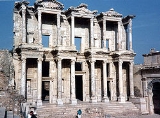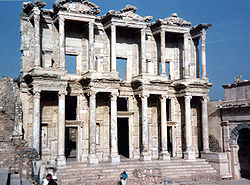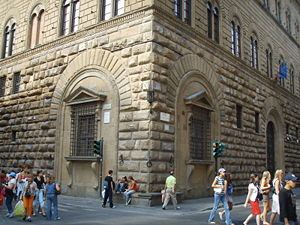
Aedicula
Encyclopedia

Religion in ancient Rome
Religion in ancient Rome encompassed the religious beliefs and cult practices regarded by the Romans as indigenous and central to their identity as a people, as well as the various and many cults imported from other peoples brought under Roman rule. Romans thus offered cult to innumerable deities...
, an aedicula (plural aediculae) is a small shrine
Shrine
A shrine is a holy or sacred place, which is dedicated to a specific deity, ancestor, hero, martyr, saint, daemon or similar figure of awe and respect, at which they are venerated or worshipped. Shrines often contain idols, relics, or other such objects associated with the figure being venerated....
. The word aedicula is the diminutive
Diminutive
In language structure, a diminutive, or diminutive form , is a formation of a word used to convey a slight degree of the root meaning, smallness of the object or quality named, encapsulation, intimacy, or endearment...
of the Latin
Latin
Latin is an Italic language originally spoken in Latium and Ancient Rome. It, along with most European languages, is a descendant of the ancient Proto-Indo-European language. Although it is considered a dead language, a number of scholars and members of the Christian clergy speak it fluently, and...
aedes, a temple building or house.
Many aediculae were household shrine
Shrine
A shrine is a holy or sacred place, which is dedicated to a specific deity, ancestor, hero, martyr, saint, daemon or similar figure of awe and respect, at which they are venerated or worshipped. Shrines often contain idols, relics, or other such objects associated with the figure being venerated....
s that held small altar
Altar
An altar is any structure upon which offerings such as sacrifices are made for religious purposes. Altars are usually found at shrines, and they can be located in temples, churches and other places of worship...
s or statue
Statue
A statue is a sculpture in the round representing a person or persons, an animal, an idea or an event, normally full-length, as opposed to a bust, and at least close to life-size, or larger...
s of the Lares
Lares
Lares , archaically Lases, were guardian deities in ancient Roman religion. Their origin is uncertain; they may have been guardians of the hearth, fields, boundaries or fruitfulness, hero-ancestors, or an amalgam of these....
and Penates. The Lares were Roman deities
Religion in ancient Rome
Religion in ancient Rome encompassed the religious beliefs and cult practices regarded by the Romans as indigenous and central to their identity as a people, as well as the various and many cults imported from other peoples brought under Roman rule. Romans thus offered cult to innumerable deities...
protecting the house and the family household gods. The Penates were originally patron gods (really genii
Genius (mythology)
In ancient Roman religion, the genius was the individual instance of a general divine nature that is present in every individual person, place or thing.-Nature of the genius:...
) of the storeroom, later becoming household gods guarding the entire house.
Other aediculae were small shrines within larger temple
Temple
A temple is a structure reserved for religious or spiritual activities, such as prayer and sacrifice, or analogous rites. A templum constituted a sacred precinct as defined by a priest, or augur. It has the same root as the word "template," a plan in preparation of the building that was marked out...
s, usually set on a base, surmounted by a pediment and surrounded by columns. In Roman architecture the aedicula has this representative function in the society. They are installed in public buildings like the Triumphal arch
Triumphal arch
A triumphal arch is a monumental structure in the shape of an archway with one or more arched passageways, often designed to span a road. In its simplest form a triumphal arch consists of two massive piers connected by an arch, crowned with a flat entablature or attic on which a statue might be...
, City gate
City gate
A city gate is a gate which is, or was, set within a city wall. Other terms include port.-Uses:City gates were traditionally built to provide a point of controlled access to and departure from a walled city for people, vehicles, goods and animals...
, or Therm
Therm
The therm is a non-SI unit of heat energy equal to 100,000 British thermal units . It is approximately the energy equivalent of burning 100 cubic feet of natural gas....
es. The Celsus
Celsus
Celsus was a 2nd century Greek philosopher and opponent of Early Christianity. He is known for his literary work, The True Word , written about by Origen. This work, c. 177 is the earliest known comprehensive attack on Christianity.According to Origen, Celsus was the author of an...
Library in Ephesus
Ephesus
Ephesus was an ancient Greek city, and later a major Roman city, on the west coast of Asia Minor, near present-day Selçuk, Izmir Province, Turkey. It was one of the twelve cities of the Ionian League during the Classical Greek era...
(2. c. AD) is a good example. From the 4th century Christianization of the Roman Empire onwards such shrines, or the framework enclosing them, are often called by the Biblical term tabernacle
Tabernacle
The Tabernacle , according to the Hebrew Torah/Old Testament, was the portable dwelling place for the divine presence from the time of the Exodus from Egypt through the conquering of the land of Canaan. Built to specifications revealed by God to Moses at Mount Sinai, it accompanied the Israelites...
, which becomes extended to any elaborated framework for a niche, window or picture.
Gothic aediculae
As in Classical architectureClassical architecture
Classical architecture is a mode of architecture employing vocabulary derived in part from the Greek and Roman architecture of classical antiquity, enriched by classicizing architectural practice in Europe since the Renaissance...
, in Gothic architecture
Gothic architecture
Gothic architecture is a style of architecture that flourished during the high and late medieval period. It evolved from Romanesque architecture and was succeeded by Renaissance architecture....
, too, an aedicule or tabernacle frame is a structural framing device that gives importance to its contents, whether an inscribed plaque, a cult object, a bust or the like, by assuming the tectonic vocabulary of a little building that sets it apart from the wall against which it is placed. A tabernacle frame on a wall serves similar hieratic functions as a free-standing, three-dimensional architectural baldaquin or a ciborium
Ciborium (architecture)
In ecclesiastical architecture, a ciborium is a canopy or covering supported by columns, freestanding in the sanctuary, that stands over and covers the altar in a basilica or other church. It may also be known by the more general term of baldachin, though ciborium is often considered more correct...
over an altar
Altar
An altar is any structure upon which offerings such as sacrifices are made for religious purposes. Altars are usually found at shrines, and they can be located in temples, churches and other places of worship...
.
In Late Gothic settings, altarpiece
Altarpiece
An altarpiece is a picture or relief representing a religious subject and suspended in a frame behind the altar of a church. The altarpiece is often made up of two or more separate panels created using a technique known as panel painting. It is then called a diptych, triptych or polyptych for two,...
s and devotional images were customarily crowned with gable
Gable
A gable is the generally triangular portion of a wall between the edges of a sloping roof. The shape of the gable and how it is detailed depends on the structural system being used and aesthetic concerns. Thus the type of roof enclosing the volume dictates the shape of the gable...
s and canopies supported by clustered-column piers, echoing in small the architecture of Gothic churches. Painted ædicules frame figures from sacred history in initial letters of Illuminated manuscript
Illuminated manuscript
An illuminated manuscript is a manuscript in which the text is supplemented by the addition of decoration, such as decorated initials, borders and miniature illustrations...
s.
Renaissance aediculae

High Renaissance
The expression High Renaissance, in art history, is a periodizing convention used to denote the apogee of the visual arts in the Italian Renaissance...
; Italian precedents were imitated in France, then in Spain, England and Germany during the later 16th century.
Post-Renaissance classicism
Aedicular door surrounds that are architecturally treated, with pilasters or columns flanking the doorway and an entablatureEntablature
An entablature refers to the superstructure of moldings and bands which lie horizontally above columns, resting on their capitals. Entablatures are major elements of classical architecture, and are commonly divided into the architrave , the frieze ,...
even with a pediment
Pediment
A pediment is a classical architectural element consisting of the triangular section found above the horizontal structure , typically supported by columns. The gable end of the pediment is surrounded by the cornice moulding...
over it came into use with the 16th century. In the neo-Palladian revival in Britain, architectonic aedicular or tabernacle frames, carved and gilded. are favourite schemes for English Palladian mirror frames of the late 1720s through the 1740s, by such designers as William Kent
William Kent
William Kent , born in Bridlington, Yorkshire, was an eminent English architect, landscape architect and furniture designer of the early 18th century.He was baptised as William Cant.-Education:...
.
Other aedicula
Similar small shrines, called naiskoiNaiskos
The naiskos is a small temple in Classical order with columns or pillars and pediment. Often applied as an artificial motif, it is not rare in ancient art...
, are found in Greek religion, but their use was strictly religious.
Aediculae exist today in Roman cemeteries as a part of funeral architecture.
Presently the most famous Aedicule is situated inside the Holy Sepulchre in Jerusalem.

